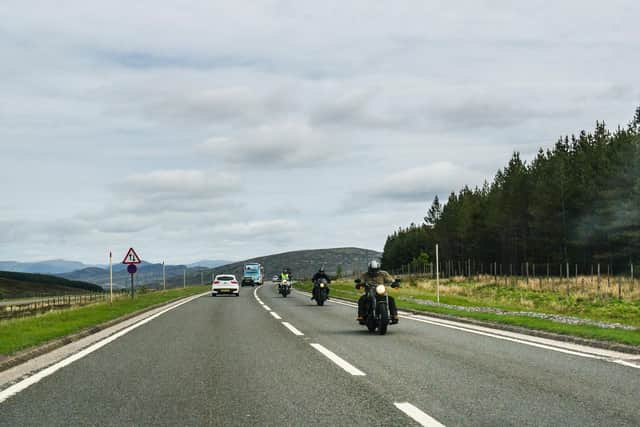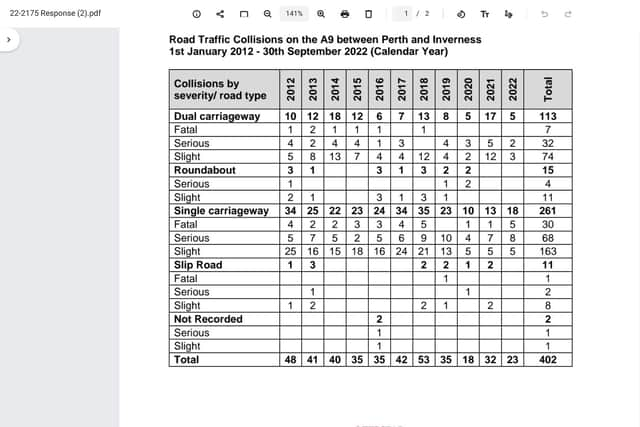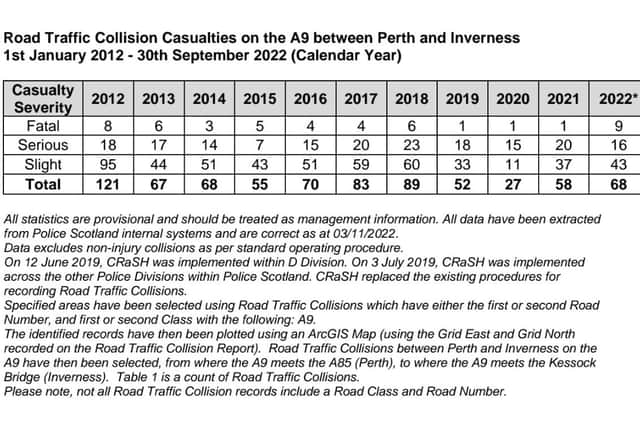A9 Perth-Inverness single carriageway deaths outnumber those on dualled sections by 20 to one
The huge disparity revealed in the Police Scotland figures obtained from a Freedom of Information request is despite nearly one third of the 110-mile road being dualled.
A motoring group said the “horrific” figures underlined the “undeniable need to accelerate” completion of the remaining 75 miles of dualling.
Advertisement
Hide AdAdvertisement
Hide AdTransport minister Jenny Gilruth has confirmed the Scottish Government’s commitment to complete the mammoth project, but the planned finishing date of 2025 is widely seen as unachievable.


The scheme is one of the largest in Scotland’s history, with the final cost uncertain because its £3 billion estimate was published a decade ago.
The police figures show there has only been one fatal collision on dualled sections since 2017, believed to have involved a single death, compared to 16 collisions on single carriageway sections, involving 20 deaths.
The figures only include nine of this year’s deaths, which have reached 12 – the highest since 2010. They compare to one death on the road in each of the past three years. There was also a single pedestrian death on a slip road on a dualled section in Inverness in 2019, which is listed separately in the figures.
The latest spate of deaths led to Ms Gilruth announcing £95,000 of further interim safety measures two weeks ago, including improved signs and road markings at Ballinluig, south of Pitlochry, Bruar, north of Blair Atholl, and Ralia, south of Newtonmore.


Three people died at Ralia in August, while there have been several fatal and serious crashes at Bruar over the past four years.
Neil Greig, the Scotland-based policy and research director of the IAM RoadSmart motoring group, said: “These horrific figures simply show the undeniable need to accelerate the upgrade of the A9 to full dual carriageway status all the way from Perth to Inverness."
Mr Greig, who is also a member of the A9 Safety Group, which is chaired by Ms Gilruth, said: “Modern dual carriageways are safer than single carriageways and for a critical artery such as the A9, the case for improvement is clear.
Advertisement
Hide AdAdvertisement
Hide Ad"Countless people will have had their lives turned upside down by the deaths on the A9 so far this year – the highest figure for more than a decade.


"We welcomed the short-term measures announced by Transport Scotland to improve safety on the road, but without a firm date for the completion of the long-promised A9 dualling project, users will be worried the A9 is fast regaining its reputation for danger. This not only risks undermining all the progress made in recent years, but could impact the local economy as recession looms.”
Scottish Conservative transport spokesperson Graham Simpson said: “These figures illustrate the stark difference in safety between the dualled and single carriageway sections of the A9.
"Although the dual carriageway is almost a third of the road, it accounts for only a tiny fraction of the fatal accidents.
“Despite the SNP having pledged 15 years ago to complete this essential work by 2025, there are still some 70 miles that require upgrading, and absolutely no prospect of this target being met. The SNP Government must ignore the anti-car Greens and finally make good on its promise before even more lives are tragically and needlessly lost.”
Neil Bibby, Scottish Labour’s transport spokesperson, said: “These are heart-breaking figures. While we welcome the new plan to upgrade safety on the A9, I would question why this is only being done now given these figures show an unacceptable number of accidents on this dangerous road over many years.
“The priority now has to be putting in place effective safety measures which prevent the kinds of accidents we are seeing on the A9. We know the experts believe this will take more than the enhanced signage and road marking promised by the Scottish Government.”
Mark Ruskell, transport spokesperson for the Scottish Greens, who are in a power-sharing deal with the SNP, said: "We need to make the A9 safer. When I speak to local communities, the message is clear. They want us to improve the dangerous junctions and reduce speeds.
Advertisement
Hide AdAdvertisement
Hide Ad"Dualling every last inch will do neither of these things. Rather than spending billions on fuelling traffic growth, which is what would happen with a full dualling project, we should be investing in genuine road safety improvements to protect lives across Scotland."
The Scottish Government’s Transport Scotland agency, which is responsible for the project, said its current cost estimate remained at £3bn at 2008 prices, but did not say when it would be finished.
Its spokesperson said: “We are working hard to bring the benefits of the A9 dualling programme to Scotland, one of the biggest transport infrastructure projects in Scotland’s history.
“We have already invested approximately £431 million to date delivering the programme, with work ongoing to determine the most suitable procurement options for the remaining sections.
"This is a complex exercise which looks at a number of factors including how the programme can be delivered most efficiently by the industry within the original cost estimate, whilst minimising disruption to road users and helping to support economic recovery post-Covid.
“We will of course update Parliament when this work is completed.”
Comments
Want to join the conversation? Please or to comment on this article.